2025 Prom Fashion Trends: Designer Dress Predictions by Jovani
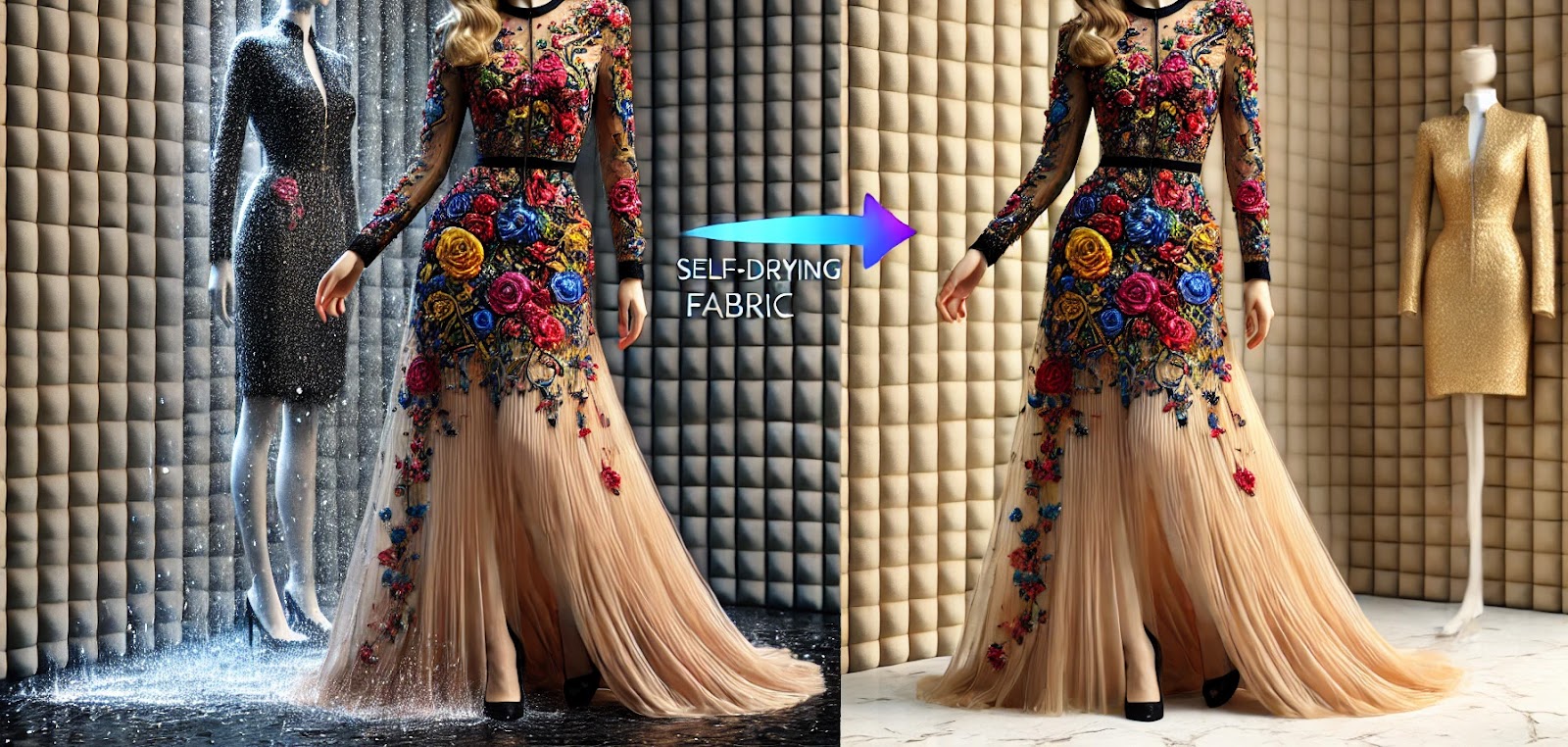
Technology is reshaping the world of fashion, bringing exciting, smart, and sustainable designs to life. Imagine prom dresses that can change colors with a touch, adjust to the weather, or even light up like fireflies in the night. These incredible innovations, like glow-in-the-dark gowns and self-drying fabrics, are changing how we think about clothing. In this article, we’ll dive into these creative breakthroughs and show how they’re making prom fashion more interactive, eco-friendly, and practical for everyday life. Jovani is part of the elite selection of designers offering formal, long prom dresses for the 2025 prom season.
Transformative Fashion Technologies:
1. Color-Changing and Pattern-Adaptive Dresses
- Concept: Prom Dresses that change color or patterns based on temperature, light, or app controls.
Technology:
- Thermochromic Fabrics: Adding Magic to Prom Dresses
- App-Controlled LEDs: A Bright Idea for Prom Dresses
- Runway-Ready Elegance: Perfect for Prom, Parties, and Special Occasions
Glow-in-the-Dark Prom Dresses: Illuminating Style with Modern Innovation
Picture yourself at prom in a dress that glows softly, making you the center of attention all night long. These dresses aren’t just beautiful—they’re also powered by sunlight! Inspired by the natural glow of sea creatures, they use small, hidden solar panels to create a magical light effect. Not only are they eye-catching, but they’re also an eco-friendly choice for a memorable evening. Let’s take a closer look at how these amazing dresses work and why they’re becoming the next big thing in prom fashion.
Concept:
The idea behind this dress is simple yet fascinating—it’s designed to glow in the dark, much like how some sea creatures, like jellyfish, light up in the ocean. This magical effect is created using tiny lights or special fabrics built into the dress. What makes it even more special is that the dress is powered by sunlight. During the day, hidden solar panels collect energy, which is then used to make the dress glow at night. It’s a stunning combination of style, technology, and eco-friendliness, perfect for anyone who wants to shine—literally—on their big night!
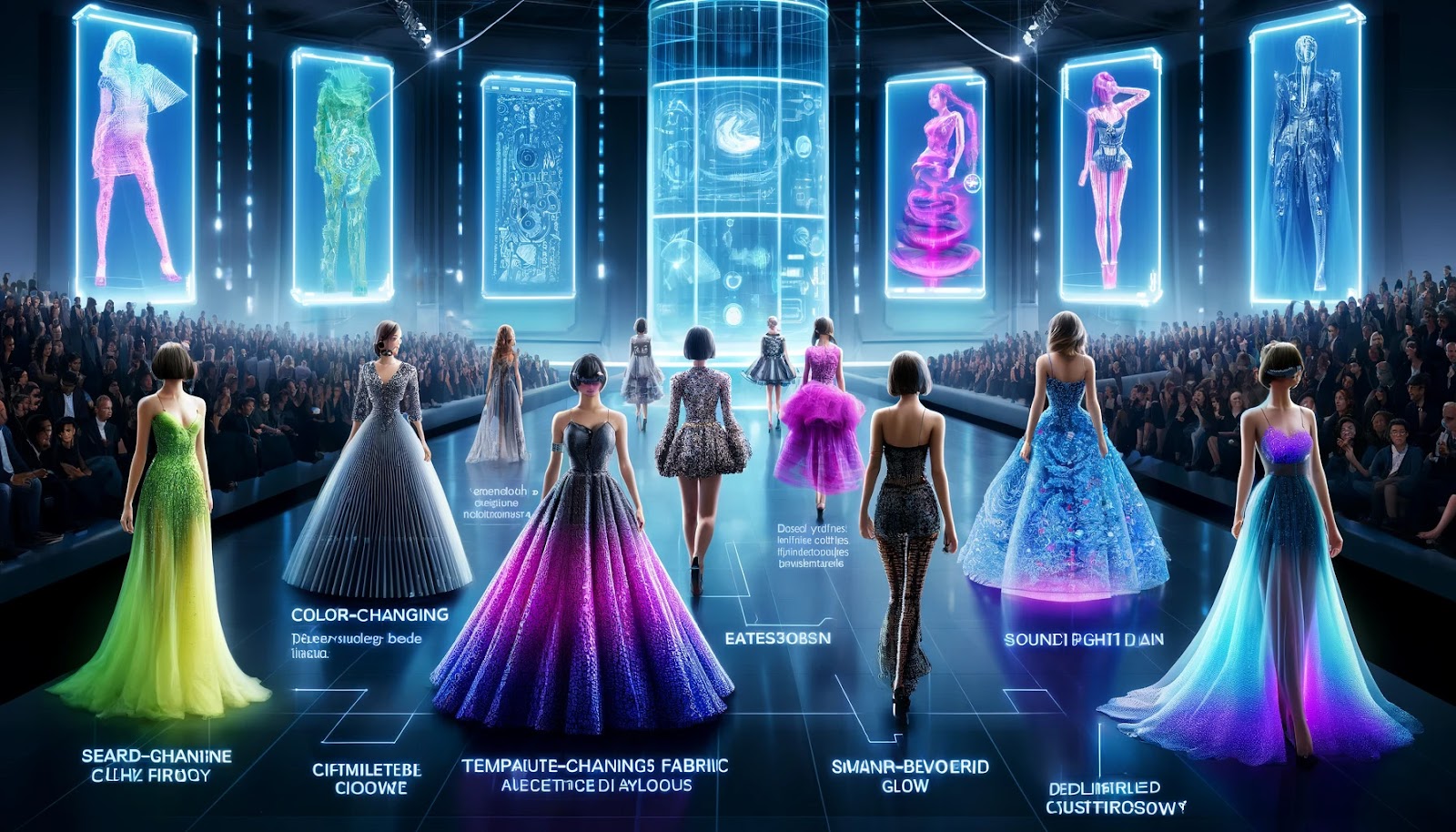
This image shows an advanced AI and technology-driven prom dress. It contains up-to-the-minute ideas represented by color-changing cloth, patterns that respond to temperature, inflatable accents, etc.
The Role of Technology in Revolutionizing Prom Fashion
1. Glowing Fabric: Lighting Up Prom Fashion with Style and Innovation
Material: It consists of fabrics having either particles or LEDs embedded within them which These lights create a gentle, radiant effect that makes the dress stand out in dim settings. The technology behind this fabric allows it to shine in a way that feels natural, without being too bright or overwhelming. It’s like wearing a dress with its own built-in glow, adding a unique and elegant touch to your outfit.
Function: When activated, these tiny lights or particles emit a soft, radiant glow that adds a magical touch to any outfit. The brightness and color can be easily adjusted, allowing wearers to customize their look to perfectly match their style, mood, or the occasion.
Solar Panels: Powering the Future of Prom Fashion with Radiant Innovation
Incorporation: Solar panels are seamlessly integrated into the fabric of the dress, discreetly placed in areas like the back or sides where they remain hidden. This ensures the dress maintains its elegant appearance while harnessing energy efficiently.
Charging: The solar panels capture sunlight and convert it into electric energy, which is then stored in small batteries or capacitors hidden within the dress. This stored energy powers the dress’s unique features, ensuring it remains both functional and stylish.
Power Supply: The stored energy powers the glowing parts of the dress, allowing it to light up beautifully at night or in dimly lit settings without needing any external power source.
Control Mechanism: Customizable Controls for Fashion Elegance
App-Controlled: Personalizing Dresses with Ease: This feature allows wearers to connect their smartphones to the gown, giving them full control over brightness, colors, and patterns. This level of personalization elevates the fashion experience, making these dresses perfect for creating unique looks that suit any prom night, event, or mood.
Automatic Activation: Smart Sensors for Seamless Prom Fashion Glow: The dress features smart sensors that detect the surrounding light levels. When it gets dark, these sensors automatically activate the glowing elements, ensuring the dress lights up effortlessly. This hands-free functionality adds convenience and enhances the magical appeal of designer prom dresses for unforgettable evenings.
How It Works: Effortlessly Smart Prom Fashion Innovation
Integration: These panels are discreetly incorporated into the dress fabric, normally at less noticeable areas like back or sides.
Charging: During daytime, sunlight is harnessed by these cells then converted into electric current before being stored in small light batteries or capacitors that are located somewhere within the clothing itself.
Power Source: Having saved up some energy, now it can be used to power bioluminescent elements hence enabling our gown give off light at night or under dimly lit conditions without any external sources of electricity.
Self-Activation: There might also be sensors on the dress that detect surrounding light levels and turn on bioluminescent components automatically in darkness.
Advantages:
Environmentally friendly: Solar energy reduces reliance on conventional power sources thus making such fashion eco-friendly.
Beauty: Glowing effect produced creates an attractive appearance hence making these dresses suitable for evening parties, shows among others.
Uniqueness of design: Combining technology with clothing demonstrates possibilities associated with smart textiles besides pushing boundaries set by traditional attire design. This idea merges fashion with technology while also being sustainable and interactive thereby representing one example of forward-looking apparel design.
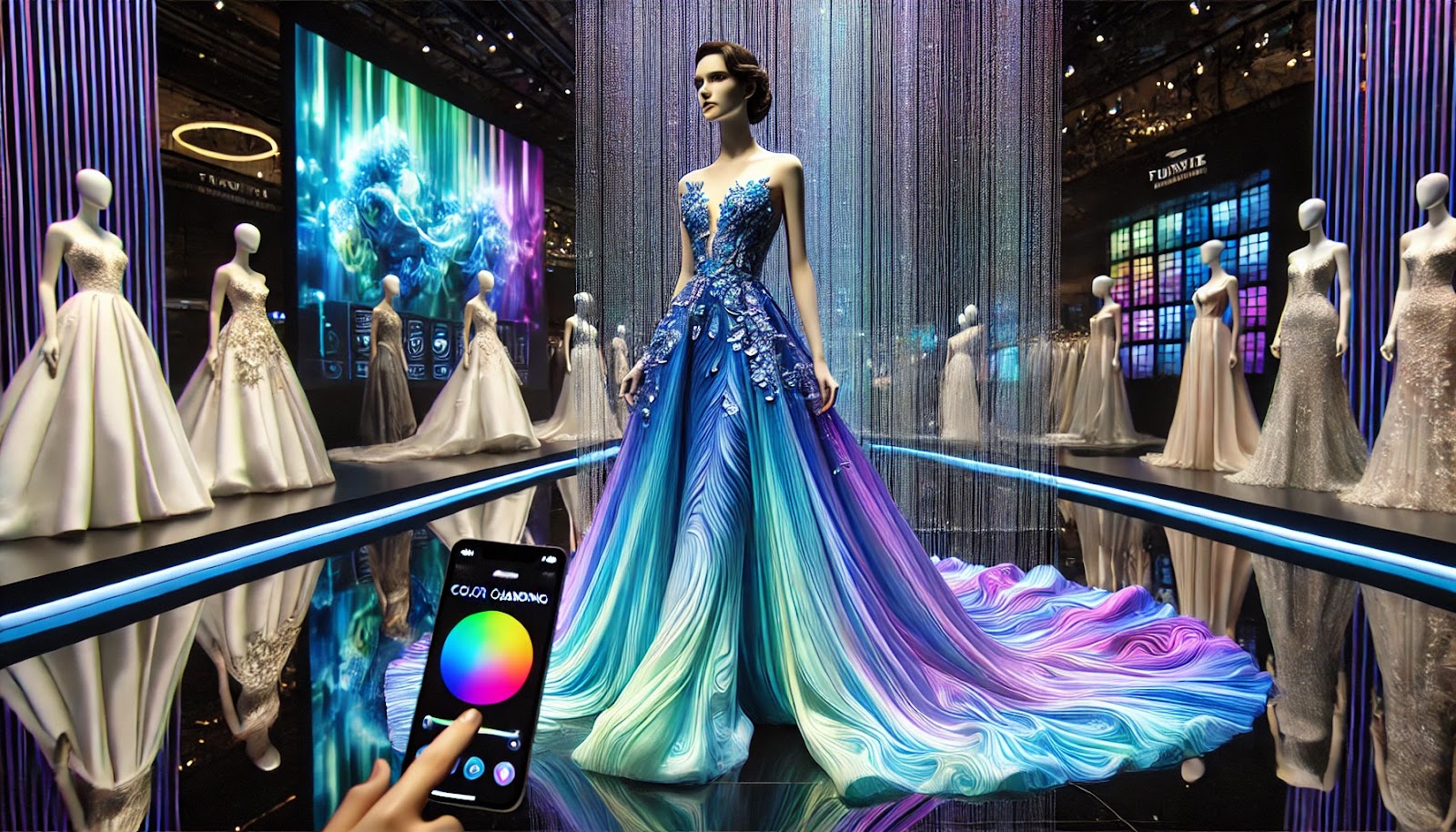
This picture depicts a dress painted in wearable light paint which illuminates at night forming intricate fascinating patterns Set against dark background so as to bring out the glowing effect associated with these outfits while at same time allowing viewers to concentrate more on details shown by realistic fabric used.
Control Mechanism:
App-Driven: It’s possible that the dress will be connected to a mobile app, which enables the wearer to manipulate the color,
brightness and pattern of the light paint. This feature makes it possible to adapt the garment for different occasions or moods so that each person can have their own unique experience when wearing it.
Manual Buttons: The costume may also include manual controls such as buttons or switches that can be used to turn on/off and adjust various settings directly without using any additional devices like smartphones or tablets.
Wiring and Connectivity:
Built-in Wiring: Soft thin wires are utilized in this system. They connect a battery pack with an EL paint while being embedded into cloth itself so as not only maintain flexibility but keep comfort as well.
Concealed Circuits: All electronic elements including wiring lines along with circuits are hidden inside clothing item making them invisible from outside what gives more aesthetic look overall.
Safety and Comfort:
Low Volts: This type of illuminant operates at low voltage levels thus being harmless when in contact with human skin for example during wearing this outfit. Electricity needed is very little hence no danger posed towards people who wear such clothes either children among others too.
Airy Material: Dressing made out of breathable fabric should still allow enough air circulation despite having added light paints and other electronic parts that may block off some ventilation paths otherwise found naturally within them .
How It Works:
Switching On: Light-emitting paint is activated by a wearer through controls provided on either smartphone apps or directly via manual buttons integrated into garments themselves if need be.
Lightning Up – Powering Up/Down / Changing Color(s):In order or it to show different colors at different times based on user preferences; power supplied from batteries stored within battery packs would cause electric current flow across these thin flexible wires until they reach EL paints thereby causing them emit lights whose intensity varies according its programmed patterns which can easily done by this smart clothing.
Rechargeable: After using this attire, one can recharge the battery pack to ensure it’s ready for the next use.
The frequency of recharging will depend on how often the dress is worn and how long it is used each time. This makes it convenient and reusable for multiple occasions.
Advantages:
Stunning Visuals: The dress is suitable for evening occasions, parties and fashion parades because of the luminous paint that it has.
Personalization: It enables one to make a dynamic statement in fashion as they can control the light settings.
Creativity: This tech shows how high-end materials can be combined with clothes thus challenging conventional approaches to making garments. Wearable light paint technology is a major breakthrough where fashion meets technology paving way for more interesting designs in future clothes.
A sound-activated light-up dress that responds to music. The dress is made of LED lights and creates different patterns which match the music being played alongside it in a futuristic fashion show setting.
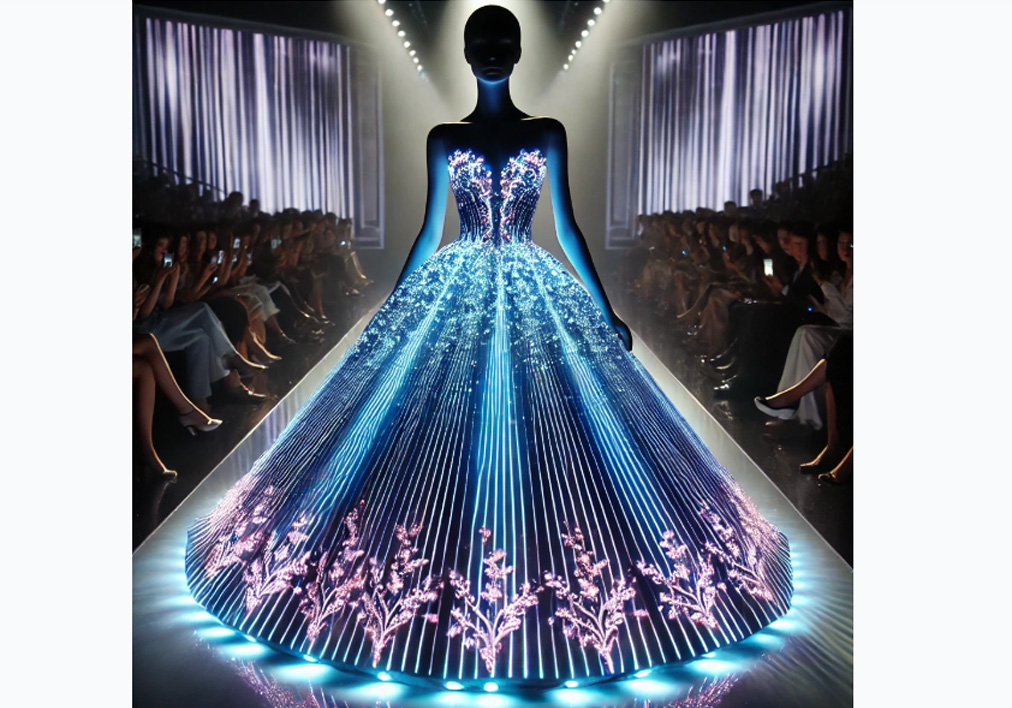
Here is a visually striking representation of a sound-activated prom dress on a runway show, highlighting its vibrant LED illumination synchronized to music. Let me know if you’d like any modifications!
Concept and Technology of Sound Activated Light Up Dress
A sound activated light up dress is an innovative garment that illuminates according to audio signals produced by the surrounding music or ambient noise. This produces an eye-catching visual effect that can enhance one’s presence at parties, concerts and other gatherings where we go dressed to impress. To achieve these effects, the design merges advanced audio detection technology with LED lighting.
Technology:
Microphone and Sound Sensor:
Integration of Microphone: It has got a highly sensitive microphone capable of picking up sounds from its environment as well as those produced by the wearer.
Sound Sensor: This device picks up sound and turns it into signals that control the LEDs on the dress. The sensor is usually placed within or near the fabric to stay hidden and blend seamlessly into the design.
LED Lights:
Flexible LED Strips: These strips are designed in such a way they can flexibly follow any movement made while wearing clothes thus creating mesmerizing patterns all over it.
Variety of Colors: Different hues may emanate from individual diodes allowing users to come up with various stunning visual displays.
Control Unit:
Microcontroller: The small-sized microcontroller chip processes data originating from sound sensors before deciding how lights should blink based on rhythms generated by music or any other background noise around us.
Programmable Settings: The dress lets you customize the lighting effects based on the music or sounds around you. For example, fast beats can make the lights flash quickly, while slow tones create gentle, flowing light patterns. You can adjust these settings to match the mood of any event.
Power Source:
Rechargeable Battery: A rechargeable battery pack powers the dress which is discreetly placed within its structure. It supplies energy to microphones, sound sensors and LED lights.
Battery Life: These packs can keep us glowing for several hours continuously before needing recharging via USB ports available on most devices in use today.
Fabric Integration:
Seamless Design: Wires together with other electronic components have been seamlessly stitched into textiles so as not to interfere with comfortability or flexibility expected from any normal piece of clothing. This also ensures that weight remains minimal making it easy for people wear them wherever they want without feeling weighed down at all.
How Sound Activated Light Up Dress Works:
Sound Detection: The built-in microphone is able to detect all sounds coming from outside world including music playing nearby or even people talking around wearer.
Data Processing: Detected audio signals are analyzed by a sensor that converts them into digital format suitable for interpretation by a microcontroller chip located somewhere within reach but still concealed beneath layers of fabric forming the main body part where most LEDs reside upon this particular type of clothing’s surface area.
Light Activation: Once the sound is detected and processed, the controller turns on the lights in specific areas of the dress based on where the sound is coming from, like nearby speakers. The lights sync with the beat of the music, creating an eye-catching visual effect, especially in darker settings or nighttime events.
Benefits:
Interactive Experience: This dress provides visually interactive features for better immersion in the environment;
Customization – One can always personalize lighting patterns using programmable settings hence suiting various occasions and moods as well.
Innovation: This technology is a good example of how fashion and technology can be combined to create unique clothing designs that are also interesting.
Applications:
Parties and Events: The dress is perfect for parties, concerts or any other event with music as the main theme.
Fashion Shows: It can be worn during fashion shows to showcase advanced design concepts that involve elements like electronics and computer programming.
Performances: Entertainers can wear this garment to make themselves more visible on stage while providing the viewers with a visually stimulating show. By combining clothes with sound-activated technology, one can increase their personal style at different occasions in an unusual manner.
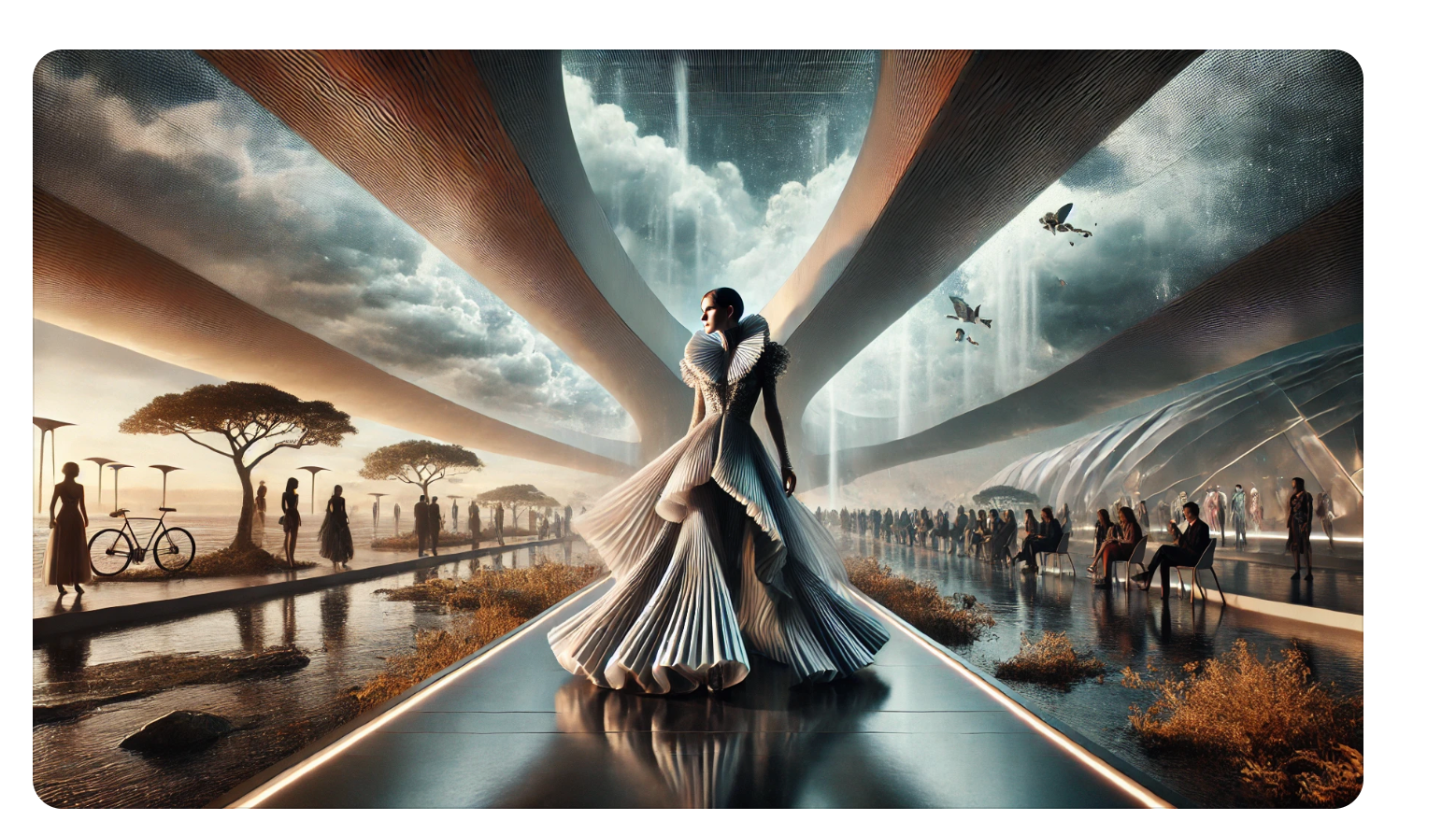 Elegance Meets Innovation: A Climate-Adaptive Dress Designed for Any Weather.
Elegance Meets Innovation: A Climate-Adaptive Dress Designed for Any Weather.
Climate-Adaptive Dress: Fashion Ready for Any Weather
Imagine wearing a perfect prom dress that adjusts to the weather around you, keeping you comfortable and stylish no matter the conditions. A climate-adaptive dress does just that. Designed with wind-proof layers and advanced materials, it offers protection against harsh winds while maintaining a sleek and fashionable look. Whether it’s a breezy evening or a sunny day, this dress combines practicality and elegance, making it a must-have for outdoor events and unpredictable weather.
Concept and Technology behind Climate Adaptive Dress with Wind Proof Layers
Concept:
The climate adaptive dress is meant to keep an individual warm and protected from different weather conditions at the same time looking sophisticated and stylish. It uses smart materials and design elements that respond to changes in the environment specifically wind; this ensures comfort for the wearer and makes the garment look perfect under any circumstances.
Technology:
Wind Proof Layers
Material: The dress is made of modern breathable textiles which have wind proof layers, they are light but strong enough so as to act as a barrier against strong winds yet allow ventilation preventing overheating.
Construction:
Within its structure there’re strategically placed windproof areas like skirt and sleeves where they’re more likely to be affected by breezes therefore not losing shape neither elegance even when it’s windy out there.
Climate Adaptive Fabric:
Thermo-Regulating Fabric: This kind of fabric can regulate heat transfer depending on external temperatures thus helping one stay warm in colder environments or cool down when it gets hot.
Moisture-Wicking: Comfort and Elegance for Prom Dresses
Another feature possessed by this type of cloth is moisture wicking capability; sweat from our bodies may evaporate quickly through such material, leaving us dry throughout.
Smart Design Features:
Adjustable Components: Drawstrings, zippers or snap fasteners that can be used for loosening/tightening different parts of Clothing according to prevailing climatic conditions may form part of attire design e.g., hemline may be adjusted so as not let skirt blow up during windy days.
Layer Integration: Extra removable/hidden layers could be included into garment which could be added/removed depending on atmospheric pressure variations (e.g., attaching extra layer if needed).
Embedded Sensors: Smart Features for Designer Gowns
Environmental Sensors: Small sized sensors located inside dress able to monitor such environmental elements like wind speed, temperature and humidity where they send back information about them either through an app linked phone or directly displayed on cloth itself.
Automatic Adjustments: Dress responds by making adjustments like changing wind proof layers’ positions or any other adaptive features for better protection basing on inputs from sensors.
How It Works:
Wind Detection: Adaptive Technology for Stylish Prom Dresses
The wind speed and direction are continually monitored by the built-in Sensors. Whenever high winds are detected by the sensors, the dress will automatically switch on its layers that are proof against wind and adjust itself so as to minimize resistance against the wind.
Thermo-Regulation: Climate-Adaptive Innovation for Couture Gowns
What regulates this dress is its thermal properties which change with external heat. When it is cold outside, the material retains warmth but allows for cooling in hot weather. This type of fabric draws sweat away from one’s body thus leaving them dry and comfortable all day long.
User Control: Personalized Adjustments for High-Fashion Designs
The person wearing it can manually modify how tight or loose-fitting they want their clothes to be using zips, drawstrings or snaps built into them which also help in protection from winds. Through a linked application, users would not only be able to keep an eye on environmental conditions but also tweak different settings of this attire further if need be.
Benefits: Elevating Style and Functionality in Modern Fashion
Comfort and Protection: The dress is designed such that it shields somebody from strong breezes while keeping them comfy regardless of the prevailing climate around them.
Stylishness coupled with Class: This garment looks sleek even with advanced capabilities making suitable for use at places like red carpet events where fashionistas gather expecting nothing less than absolute glamour on display before their very eyes!
Innovation: Smart materials in clothing are changing the way we think about fashion. A climate-adaptive dress isn’t just stylish—it adjusts to weather changes, offering both practicality and beauty in one design. As we face challenges like global warming, this innovation opens new possibilities for clothing that is both functional and sustainable, making it perfect for the modern world.
Applications:
Outdoor Events – Perfect for activities held outside when there might Still be unpredictable weather patterns developing towards evening hours;
Fashion Shows – It would act as living proof showing off just how much designers have managed fuse nature technology together successfully without sacrificing any aspect either side represented equally well.
Everyday Wear – Great all rounder meant for everyday use regardless
of where one resides;

A couture dress made of self-drying fabric, with a ‘before’ and ‘after’ comparison. On the left side is a wet elegant colorful couture dress; on the right side is a dry vibrant one.
Self-Drying Fabric: The Future of Practical and Stylish Clothing
Imagine wearing short prom dresses that dry themselves within seconds after getting wet, keeping you comfortable and confident in any situation. Self-drying fabric is an exciting innovation in the textile industry, designed to repel water and quickly eliminate moisture. Since short dresses expose more of the body, this technology is especially beneficial in quickly drying areas that might otherwise cause discomfort. Whether caught in the rain or dealing with unexpected spills, this feature ensures your outfit stays functional and stylish without losing its appeal. It’s a perfect blend of convenience and fashion, ideal for the modern, on-the-go lifestyle. The concept of self-drying fabric is to have clothes that can get rid of water on them within seconds after being rained on or coming into contact with any other form of moisture. This new invention in the textile industry makes garments more practical and comfortable, especially when someone has no choice but to get wet under certain circumstances. The main idea behind this method is to ensure that attires, including short prom dresses, remain attractive as well as functional even if they take some time before completely drying off.
Technology:
Hydrophobic Coating:
Substance: The material used for making clothes has Hydrophobic(water-repellent) covering which makes it impossible for them to absorb any amount of liquid thus remaining dry all through. Water droplets bead up and roll off the surface instead of penetrating into its fibers due to this treatment.
Application:
Manufactures can apply this coat during production or use post-production methods like spraying so that there is no much change in appearance after adding another layer onto already finished product; moreover, these coatings are very thin and cannot be seen by naked eyes.
Nanotechnology:
Nanoparticles: Tiny particles are added to the fabric during manufacturing to make it extra water-resistant. These particles create a smooth surface that helps water roll off instead of soaking in, making the fabric far more effective at staying dry than regular treatments.
Durability: Nanotechnology ensures that hydrophobicity lasts long enough even after frequent washing since they are designed withstand multiple washings without losing effectiveness over time unlike other methods which may wear off easily under normal usage conditions.
Moisture-Wicking Properties:
Fabric Structure: The fabric features a specialized weaving or knitting pattern designed to enhance moisture-wicking properties. This structure helps distribute any absorbed moisture evenly across the surface, allowing it to dry quickly through efficient evaporation, keeping the garment comfortable and fresh.
Breathability: This cloth remains breathable throughout thus allowing free circulation air around user’s body parts covered by garment while helping them dry up too.
Heat-Responsive Fibers: Adaptive Comfort for Innovative Fashion: Some fabrics are made with heat-sensitive fibers that react to moisture. These fibers gently warm up to speed up the drying process, helping the fabric become completely dry in no time.
Embedded Heating Elements: Smart Warmth for Luxe Designs: Advanced designs involve the integration of small flexible heating elements powered by rechargeable batteries within fabric structures – such clothes may need sources of additional warmness as well expeditiousness drying time.
How It Functions: Smart Integration for Fashion Innovation
First Water Contact: While the fabric remains exposed to water, a hydrophobic covering makes droplets form and flow away by itself minimizing absorption. But any water that manages to intrude is instantly drawn off the outside of the material through its capacity for wicking moisture.
The Process of Drying: Quick Evaporation for a Comfortable and Stylish Dress:
Because of its great surface area and high breathability, this type of cloth causes quick evaporation as it allows more space for water spread all over its surface. In case such fabric contains heat sensitive fibers or built-in heating elements, they are activated thus generating extra warmth which in turn speeds up drying even further.
More Rapid Drying:
Thanks to a combination of features like hydrophobic coating; nanotechnology; moisture-wicking properties and optional heat sources incorporated into it – this material dries considerably quicker than traditional ones do.
Benefits:
Speedy Dryness: The key benefit is that the dress dries quickly after getting wet, ensuring maximum comfort and practicality while maintaining its stylish appeal.
Aesthetic Integrity While Wet: Even under wet conditions garments made from our fabrics retain their structure integrity thus keeping them looking good throughout.
Adaptability: Can be used in various fields e.g., sportswear, outdoor gear, fashion industry (attires) among others since it can serve different purposes depending on where it is utilized.
Innovation: Represents a significant advancement in textile technology overall, pushing the boundaries of what fabrics can do.
Uses:
Sports clothing:
Ideal for sportsmen requiring fast-drying garments throughout or after workouts.
Apparel for outside wear: Good for nature lovers who may get wet like hikers, campers, and sailors.
Fashion: High-end clothes like formal dresses that use self drying abilities to be fashionable as well as useful.
Casual wear: Suitable for everyday outfits which could be caught in a sudden shower or suffer from drink spillages.
Design Your Perfect Prom Dress: Customizing Fashion in Virtual Reality
Imagine being able to design your perfect mermaid prom dress, choosing every detail, and seeing it come to life before it’s even made. Virtual Reality (VR) couture makes this possible, allowing you to step into a digital world where you can customize luxe fabrics, colors, and styles to match your vision. Whether you’re dreaming of intricate embellishments or prefer simple prom dresses with timeless elegance, this technology ensures every design reflects your personal style. You can even test different hairstyles on a virtual model, such as an updo hairstyle, soft curls, or a sleek ponytail, to see how each complements your dress. This cutting-edge approach combines creativity and technology, giving you full control over the design process and ensuring your final outfit is as unique as you are.
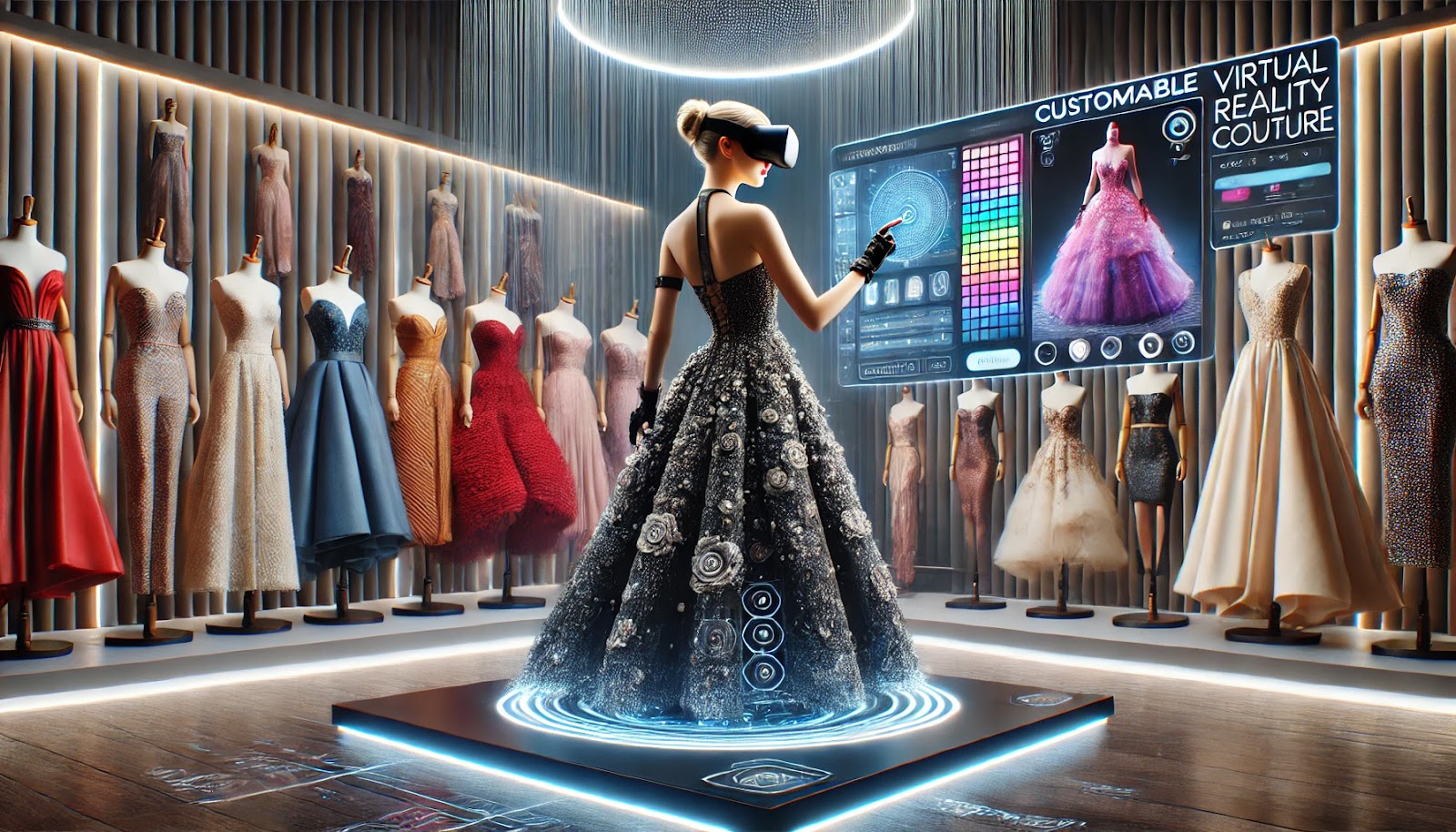
Digital customization through virtual reality fashion. A model can be seen touching an interface of virtual reality and choosing different dresses in terms of their design, color, pattern among others in real time. The background looks sleekly modern as it should for any place showcasing virtual reality couture’s innovative nature.
Technology:
Virtual Reality Interface:
VR Headset and Gloves: A VR headset and gloves incorporating sensors that follow hand motion are worn by users. This configuration enables them to interact with the virtual world naturally.
3D Visualization:
Different designs, colors, and patterns can be seen in a real-time 3D visualization of the garment on a virtual model through the VR interface.
Design Software:
Customization Platform: Various aspects of the garment can be customized using advanced design software included in the VR system. This involves selecting fabrics, colors, patterns, and styles among others.
Real-Time Rendering: The software provides immediate visual feedback by rendering changes as users modify the design in real-time.
3D Scanning and Modeling: Body Scanning: Personalized virtual models can be created by scanning body measurements. This ensures that the custom-made clothes fit perfectly well.
>3D Modeling: With this feature, scanned data is used by software to create an accurate three-dimensional representation of a user which is then employed in showing off personalized fashion items.
Fabric Simulation:
Material Properties: Different textiles’ characteristics like texture, drape or movement are simulated by this program hence giving one a realistic preview of how such garments will behave when worn.
Dynamic Interaction: Through dynamic interaction with fabrications during movement; individuals are able to see how they react thus guiding their decisions on what kind of designs would work best for them or not.
Interactive Features:
Drag and Drop: In order to customize dressing virtually; it is possible for someone to drag any design element onto an outfit. For example, adding accessories or changing necklines among others may be done through this function
Color Palette: There is wide range color palette which allows people experiment different colors combination as well as gradients.
Pattern Library: The virtual design tool offers a wide range of pre-made patterns for users to choose from, or they can create their own unique designs. These patterns can be applied to different parts of the dress, allowing for endless customization options. Once created, designs are stored in a virtual wardrobe, making it easy to revisit and reuse them for future outfits. This feature ensures that every piece you design is not only unique but also accessible whenever you need it.
Ordering and Production:
Final Design Approval: One can finalize their choices then place an order for the physical garment once they are satisfied with design.
3D Printing and Manufacturing: The design data gets sent to a manufacturing facility where different techniques such as 3d printing, laser cutting & automated sewing among others are used in creating clothes.
Quality Control: Finished products undergo quality control checks against virtual models so as to ensure that they match each other.
How It Works:
Setting up: Users should arrange VR equipment such as gloves and headsets and enter the environment of virtual design.
Customization: Users can interact with a virtual reality interface to design their garment by selecting fabrics, colors, patterns, and styles. The software provides real-time previews and instant feedback, allowing users to see their choices come to life as they make adjustments. This makes the process intuitive and ensures the final design matches their vision perfectly.
Previewing: At this point a virtual representation of the customized cloth is shown on a model that can be moved around to see how it reacts with different movements.
Adjustments: Until satisfied with what has been created user should keep making necessary adjustments until everything looks right.
Order Placement: Once the design is complete, users can place an order for a physical version of their outfit. Before production, users have the option to adjust sizes and ensure the fit is perfect, including options tailored for plus-size prom dresses. Additionally, the platform offers style suggestions and adjustments to create designs that flatter different body types, ensuring a comfortable and stunning final product that matches the user’s vision.
Production: Once the design is finalized, the manufacturing plant receives the detailed design files, which serve as a guide for creating the dress. Advanced production methods ensure that every detail, from fabric choice to stitching, matches the virtual design perfectly. This process, built entirely from virtual steps, guarantees a seamless transition from concept to reality. Whether it’s a sleek gown or a show-stopping prom night dress, the final product is crafted with precision and care to make your vision come to life.
Delivery: Once clothes have been manufactured person who bought it gets delivered back home where she/he lives ready made-to-fit attire just like any other regular package would arrive at their doorstep from some online merchant!
Benefits:
Personalization: With this technology, users can create unique outfits that fit perfectly, tailored not just to their style preferences but also to their exact body measurements. This ensures every piece is truly one-of-a-kind, made specifically for the wearer and unlike anything anyone else will ever have. Whether it’s a stunning gown or a chic dress, this level of personalization guarantees a prom night unforgettable, where your outfit is as unique and special as the memories you’ll make.
Sustainability: Because there is no need for numerous samplings before production begins because everything can be checked right away through live rendering feature thereby cutting down waste drastically while still achieving desired results even better than before sometimes;
Innovation: This invention demonstrates how powerful Virtual Reality can be within Fashion Industry as another avenue through which people may interact with fashion design concepts differently;
Convenience: You don’t have to go anywhere when you want something special made just for your size or taste, all one has to do is stay at home and order it through their own computer which will be delivered right into hands!
The above mentioned technology represents a big step forward in the history of clothes making business since it allows shoppers immerse themselves into creative process, interact with clothing items virtually before they are produced physically.
Elevating Elegance: A Couture Prom Dress with Intricate 3D-Printed Details
The use of 3D printing technology in fashion, especially for couture prom dresses, showcases how innovation can enhance creativity and precision in design. Each part of the dress is crafted with care, assembled seamlessly to create a flawless final product. These dresses demonstrate the positive impact of AI and advanced techniques in transforming traditional couture into modern masterpieces.
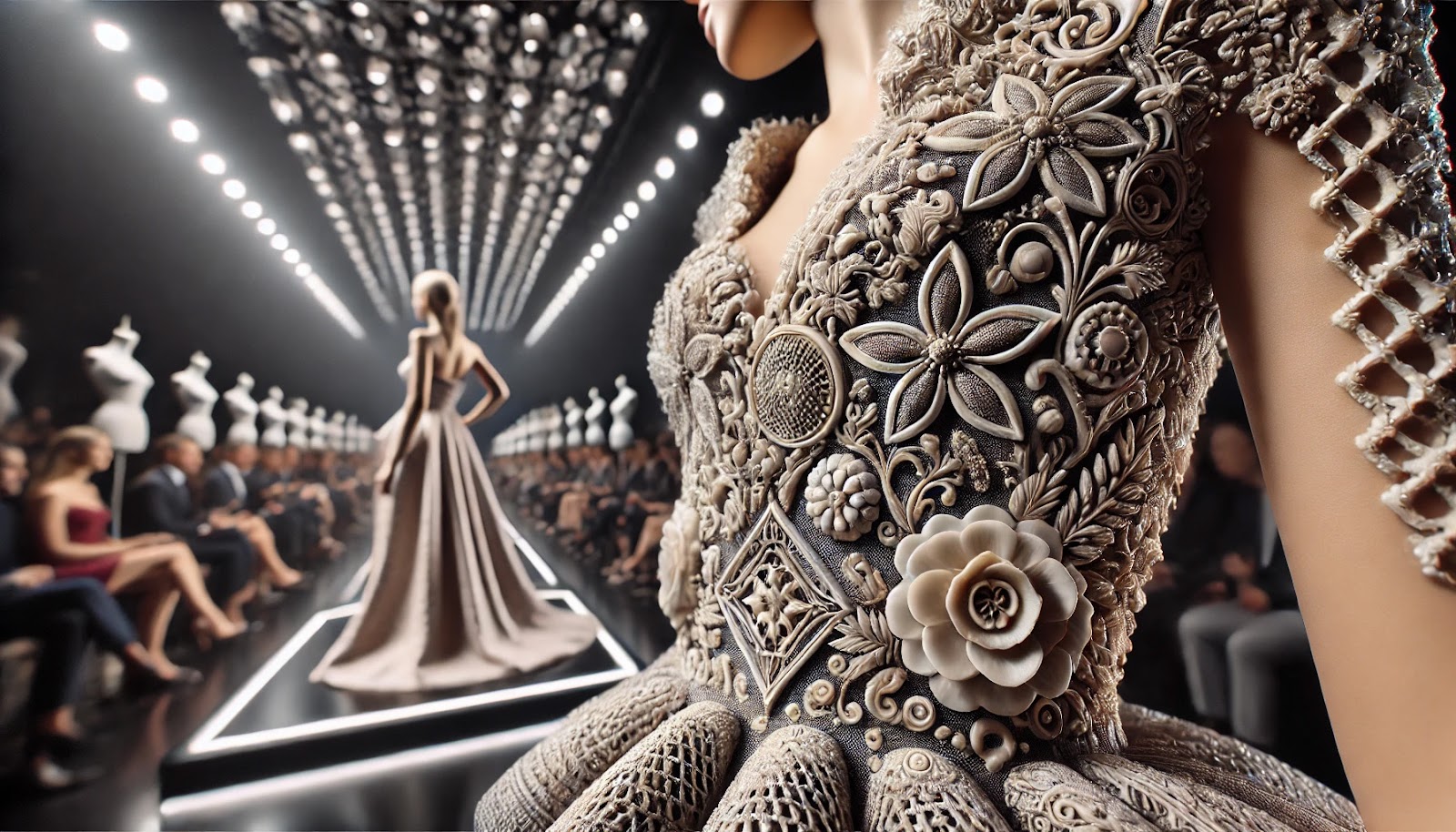
A couture dress with intricate 3D printed details is presented in the photo
3D Printed Dress: Concept and Technology
Technology:
3D Modeling Software:
Design Creation: Advanced 3D modeling software is used by fashion designers for the creation of digital dress designs. This particular program allows them to manipulate the shape, size and texture of any given 3D printed component with precision.
Customization: Unique garments are made possible through pattern and design customization options provided by this software.
Materials:
Filaments: Different types of thermoplastic filaments like PLA (Polylactic Acid), ABS (Acrylonitrile Butadiene Styrene), TPU (Thermoplastic Polyurethane) can be used as material for making 3D printed dresses. They have various characteristics such as flexibility, durability, strength etc.
Specialized Materials: Metallic filaments, carbon fiber and even biodegradable materials among others are sometimes utilized in creating high-fashion effects or sustainable fashions using 3D printing
3D Printing Process:
Layer-by-Layer Printing: The printer builds up layers one after another until it forms a full dress according to its digital model file. Intricate patterns and designs can be achieved as each layer is placed down accurately.
Multiple Components: A dress can be printed out either as one piece or several parts which will then be joined together later on during assembly stage thereby allowing for more complex designs and greater details incorporation.
Integration with Fabric:
Multiple Components: A dress can be printed out either as one piece or several parts which will then be joined together later on during assembly stage thereby allowing for more complex designs and greater details incorporation.
Integration with Fabric:
Hybrid Design: Traditional fabric may be combined with some elements made through additive manufacturing techniques like 3d printing. For example; bodice or embellishments could be done via this method while having skirt section created from cloth material.
Attachment Methods: Designer prom dresses crafted with 3D printing often require special methods to connect the different fabric parts seamlessly. These connections can be made using sewing, adhesive joining, or interlocking mechanisms. This approach ensures that even complex designs, created with advanced printers, come together perfectly. By combining precision and creativity, these techniques allow for stunning, high-quality prom dresses that feel as flawless as they look.
Finishing and Assembly:
Post-Processing: Once printing has finished, additional steps may be taken towards enhancing the look and feel of 3D printed parts. These include sanding off rough surfaces left behind by supports removal process; painting over them so that they match desired colors better etc.
Assembly: Bringing everything together, attaching these additively manufactured pieces onto corresponding locations found on clothing materials thereby ensuring seamless integration between two different worlds which would otherwise remain apart from each other forevermore
How It Works:
Design Phase: Using 3D modeling software, designers can create detailed dresses with unique patterns, textures, and structure. This process allows for full customization, ensuring the dress is made to fit your measurements perfectly and reflects your personal style.
Printing Phase:
The chosen filament material is used by a 3D printer to construct each layer of the dress according to a digital model. Elaborate or complex designs can be achieved as the printer follows instructions precisely from this digital model.
Post-Processing:
Components are refined through various post-processing techniques until they have reached their desired finish once they have been printed out. Any necessary changes or improvements will be made so that both quality and appearance standards are met with regards to 3D printing parts’ assembly into complete garments.
Assembly:
Either onto fabric itself or together as one whole piece if need be – all 3d printed components must now either be attached onto fabric itself or assembled into complete garment form before being inspected for fit/quality against designer expectations.
Advantages:
Adaptation: One of the most important things about 3D printing is that it allows for designs to be personalized to an extremely high degree, which in turn gives way to unique fashion items.
Intricacy: This technology has the ability to produce complex patterns and structures that would have been impossible or difficult using traditional methods.
Novelty: Fashion takes a step forward by adopting 3D printing as this demonstrates how revolutionary clothes-making can be with cutting-edge technologies.
Eco-Friendly: 3D printing uses only the materials needed, which helps reduce waste. It can also use biodegradable or recycled materials, making it a more sustainable option for creating dresses.
Where it can be used:
Haute Couture: 3D printers are perfect for creating one-of-a-kind pieces that are paraded on fashion runways or showrooms. These unique designs can also be tailored to your special night, ensuring you stand out on the dance floor. With the ability to modify features like adding long sleeves or intricate patterns, these dresses offer endless customization to match your personal style and make every moment unforgettable.
Costume Designing: 3D printing is great for making detailed costumes for theater, movies, and even cosplay. It allows for designs that match a character’s exact needs, making it easier to create unique and intricate outfits.
Everyday Clothing: It’s possible now more than ever before – making regular clothes but with some twist such as irregular embellishments or additional functional elements like hidden pockets etcetera.
This method represents how fashion fuses together different technological advancements thereby fostering new forms of creative design thinking while at the same time ensuring individuality through tailoring and sustainability in garment production.
Sustainable Fashion: Embracing Recycled Fabrics and Plant-Based Dyes
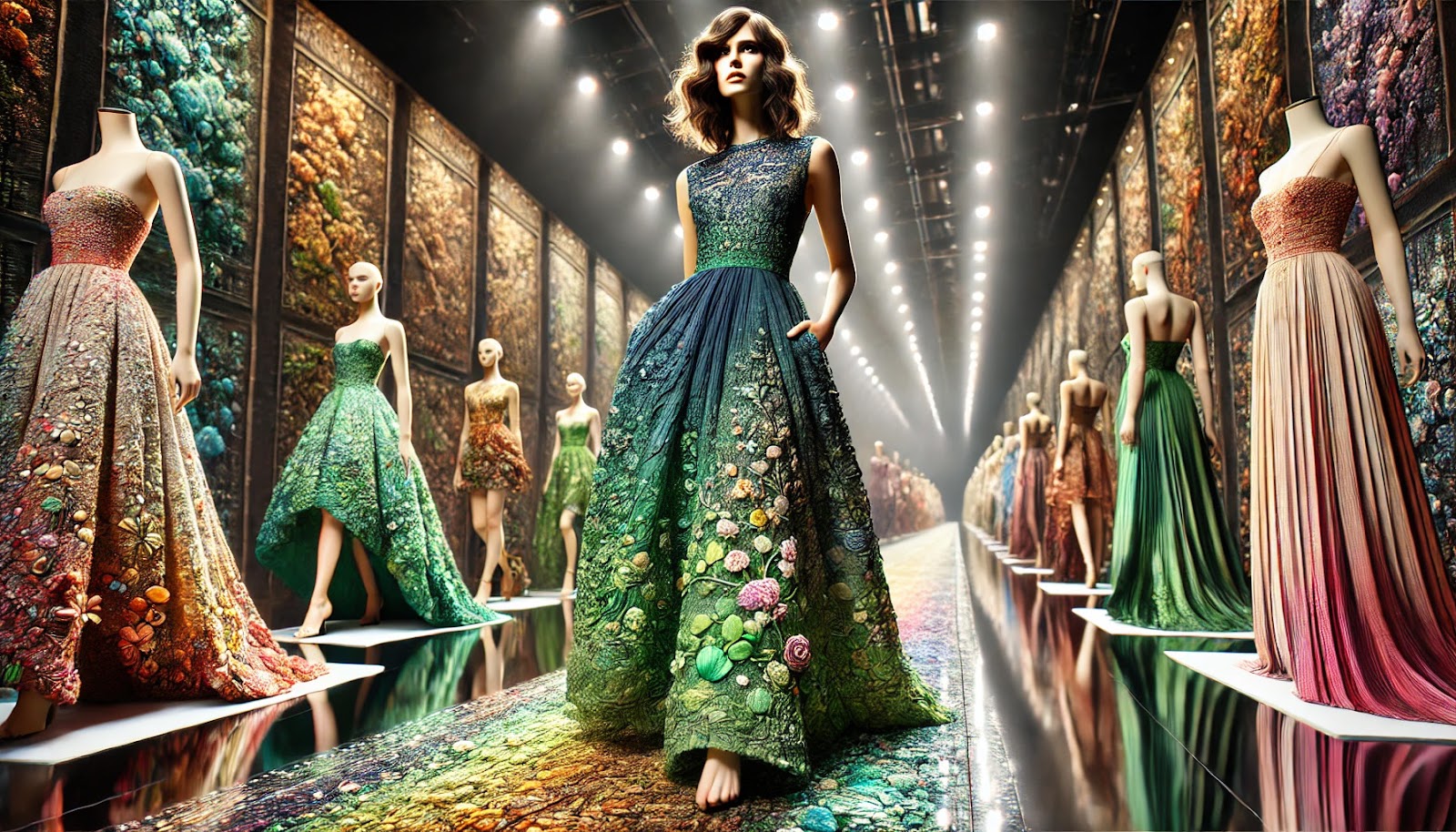
A dress made out of recycled fabrics with plant-based dyes
Sustainable fashion is transforming the way we think about clothing by using recycled fabrics and plant-based dyes. These materials not only reduce waste but also create vibrant, natural designs that are kind to the environment. Recycled fabrics give new life to old textiles, while plant-based dyes offer beautiful, chemical-free colors. Together, they showcase how fashion can be both innovative and eco-friendly, paving the way for a greener future in style.
Idea and Tech behind Recycling Fabric Employing Plant-Based Dyes
Notion: Fashioning attires through reuse textiles and coloring them with vegetable pigments. This method conserves environment by reducing waste as well as utilizing organic materials thus resulting into beautiful eco-conscious clothes.
Reused Materials: These could be obtained from various places like old clothes, textile wastes, post-consumer plastic bottles among others.
Examples of Recycled Fabrics:
- Recycled Cotton: It is produced using industrial cotton waste or old cotton garments.
- Recycled Polyester: Made by recycling polyester garments or plastic bottles.
- Recycled Nylon: Usually sourced from discarded fishing nets and other forms of nylons.
- Recycled Wool: Comes from wool textile waste or old woolen clothes.
- Recycled Silk: Produced after collecting unused silk fibers together or reworking silk waste materials.
Plant-Based Dyes:
- Sources for Natural Pigments: These are obtained from plants, fruits, vegetables, flowers and barks among others.
Common Types Of Plant-Based Dye:
- Indigo – Gives deep blue shades gotten from indigo plant leaves;
- Madder Root – Provides reds to oranges hues.
- Turmeric – Yields bright yellow shades;
- Onion Skins – Can produce anything between yellow to brown colorations;
- Hibiscus – Gives pinkish red tints.
How It Works:
Collection and Sorting:
- Recycled Fabrics: Materials come from many different places, get sorted out there, and then cleaned up which might include the separation of fabrics by their types, colors or conditions.
- Plant materials: Harvesting plants and other natural dye sources, they are then prepared for the extraction of dye.
Processing Recycled Fabrics:
- Mechanical recycling: Shredding mechanically fabric to produce new fibers. For example, old clothes made of cotton can be broken down into small pieces and then spun again until it becomes a yarn.
- Chemical Recycling: Materials like polyester are treated with chemicals to break them down into their basic parts. These parts are then used to create new fibers, giving the material a second life and reducing waste.
Dye Extraction:
- Preparation: Plant materials are chopped up soaked in boiling water so as to get out all the natural dyes contained within it.
- Dye bath: The extracted dye is mixed together with water in a container called a dye bath where the recycled fabric will be dipped inside for sometime.
Dying Process:
- Fabric Preparation: Recycled fabrics have to be pre-treated in order for them to take up dye evenly. This could involve washing and mordanting (using natural or mineral salts to fix the dye).
- Immersion: The dyed fibers are immersed into liquid solution containing extracted natural colors thereby absorbing those pigments. The longer time spent during immersion process as well as its temperature intensity determines how deep shades become.
- Rinsing & Fixing Agents: After the fabric is dyed, it is rinsed to remove any extra dye. Fixing agents are then used to make the color stay in place, often with the help of organic, eco-friendly solutions.
Fabric Production :
- Weaving or Knitting : Tinted threads spun from these fibers before being woven or knitted into cloth material.
- Finishing : Before ready for clothing production, finishing touches like washing , ironing among others need done on finished textiles.
Maintenance:
- Washing: Soft Clean: Use a mild, eco-friendly detergent with cold or lukewarm water.
- Machine Wash or Hand Wash: It is better to wash by hand or use a machine’s gentle cycle.
Drying:
- Air Dry: To prevent fading from the sun, hang it or lay it flat in a shaded area.
- Don’t Tumble Dry: Natural dyes will fade and fabric will be damaged by tumble drying.
Ironing:
- Low Heat: Iron should have low heat setting so as not to destroy fibers or colors.
- Iron Inside Out: This protects the surface and color of fabrics.
Storage:
- Cool, Dry Place: Keep them in cool dry places that are not exposed to direct sunlight so that they do not fade easily.
- No Plastic Bags: Moisture build up can be prevented by using breathable garment bags instead of plastics.
Care Tips:
- Spot Clean: For minor stains, spot clean using a mild detergent and damp cloth.
- Eco-Friendly Products: The life of the fabric and dyes can be extended by using environmentally friendly products which are also gentle on them.
Benefits:
- Environmental Impact: Sustainability is promoted as this reduces textile waste while minimizing synthetic dye usage
- Health and Safety : Being free from toxic chemicals makes plant-based dyes safe for both skin and environment
- Unique Aesthetics : Natural variations of plant based dyes make each item one off thus giving it an authentic appearance
- This is an eco-friendly process that involves recycling materials combined with natural pigments for fashionable clothes.
Smart Transformation: Dresses That Adapt for Every Occasion
Imagine a dress that offers the best of both worlds—a long, elegant gown with a full skirt and sequins that can transform into a short prom dress with just a simple adjustment. Using hidden zippers, folds, or innovative draping techniques, these adaptable dresses are designed to switch effortlessly between formal and fun.
Whether it’s a strapless gown with intricate details or a shoulder-baring style, the ability to modify the length makes these designs perfect for transitioning from a grand entrance to a lively moment on the dance floor. These versatile pieces combine sophistication and convenience, offering endless possibilities for any special event.
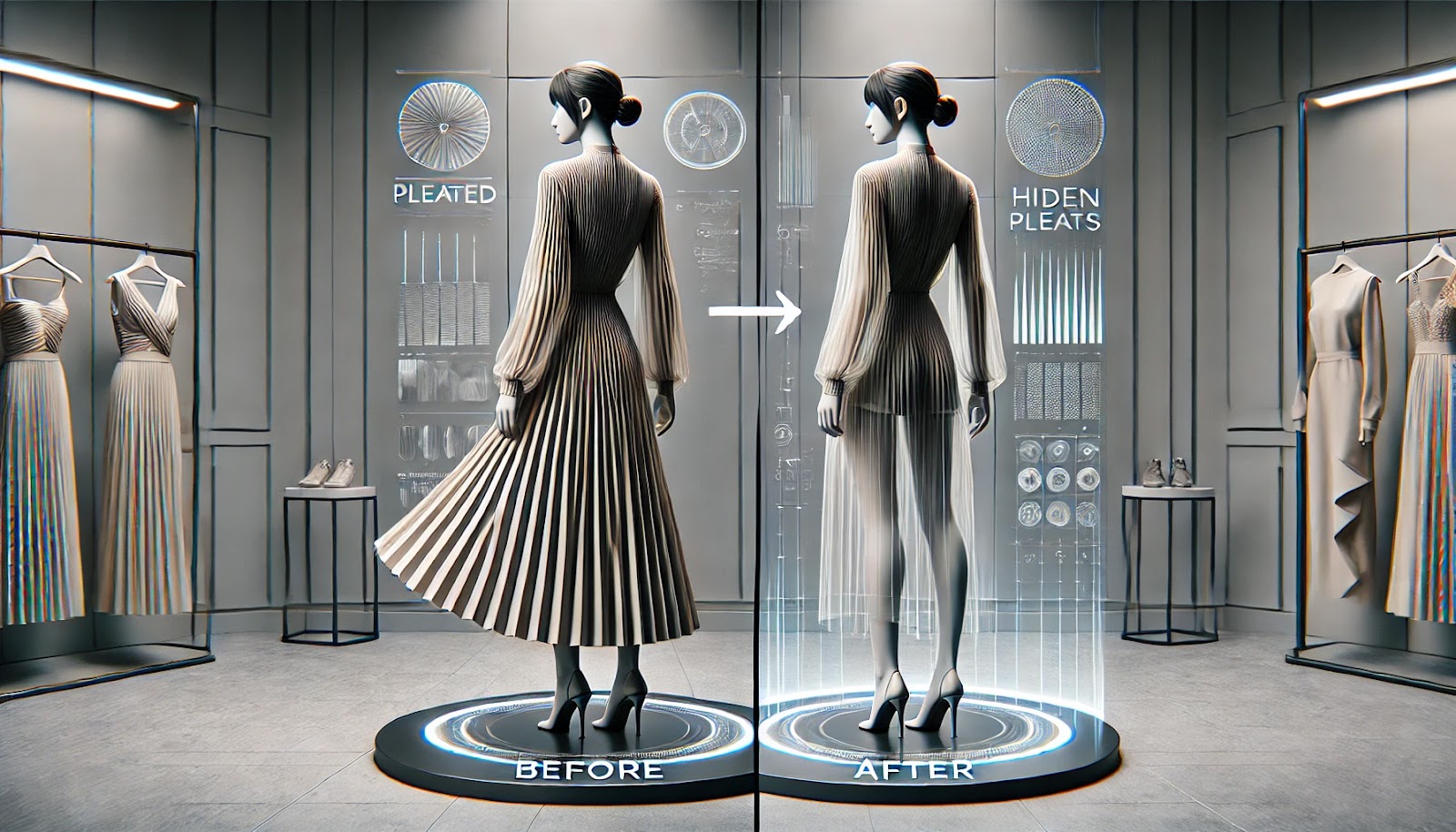
Other Artificial Intelligence and Technology Integration in the Fashion Industry
- Smart Fabrics and Wearables:
Health Tracking Clothing: Outfits with built-in detectors that can read vital signs like temperature, blood pressure and heart rate then send the data to an app for real-time health monitoring.
- Clothes That Help You Stand Straight:
Embedded sensors and actuators which detect bad posture and gently remind wearers to sit or stand up straight.
- Adaptive Thermal Clothing:
This is made of materials that change their insulation levels depending on external conditions as well as body heat so as to keep one comfortable all through.
- Hydration Monitoring:
These are intelligent textiles designed to sense dryness via sweat analysis thus warning individuals when they need water intake.
- Interactive Fashion:
Gesture-Controlled Clothing: Here, wearable technologies react to specific movements such as waving hands by changing colors or patterns on fabrics.
- Mood Clothes:
They alter color or pattern according to detected emotional states through biometric sensing.
- Augmented Reality Fashion Shows:
The use of AR enables people anywhere in the world participate virtually in fashion shows while adding virtual elements for more enhanced experiences on runways.
Sustainable and Eco-Friendly Tech:
- Blockchain for Transparency:
It refers to employing blockchains in tracking every step of production process so as authenticate sources inputs used during manufacture. - AI for Sustainable Designing:
Utilization of AI algorithms which suggest eco-friendly materials methods while optimizing fabric consumption reducing wastage at design stages itself without waiting till end-product alterations become necessary . - Waterless Dyeing Techniques:
Advanced dye technologies that save water are environmentally friendly should be applied whenever possible without compromising quality standards needed by customers. - Customization and Personalization:
3D Body Scanning: Perfectly fitting garments could be realized by scanning bodies three-dimensionally hence obtaining accurate measurements needed for tailoring clothes accordingly.
- AI-Powered Style Advice Apps:
Such applications powered by artificial intelligence (AI) systems can study one’s tastes in fashion then recommend outfits suitable for different occasions considering weather conditions among other factors. - Virtual Try-Ons:
Augmented reality apps will enable users see how clothes would appear on them or fit their bodies before making purchases – this saves time wasted returning ill-fitting items back to stores after buying online. - Innovative Fabric Technologies:
Self-Cleaning Fabrics: Textile treatment with nanoparticles ensures dirt repellency liquids hence reducing frequency washing required thereby increasing lifespan .
- Shape-Memory Alloys:
These are woven materials containing alloys that can change shape when subjected to specific stimuli (like heat); thus enabling adjustable fits and designs within garments made out of such textiles. - Energy-Harvesting Fabrics:
They generate power from wearer’s movements which may be used to run small electronic devices like mobile phones, fitness trackers etcetera; this means no need carrying extra batteries around while wearing such clothes .
Smart Accessories:
- Jewelry with AI Features :
Wearable ornaments for health monitoring voice-command enabled personal assistant capabilities among others. - Footwear Integrated Technology :
Shoes having embedded GPS tracking systems fitness functionalities heated soles regulating temperatures feet during cold weather conditions. - Bags That Think :
Handbags capable charging devices changing color match apparels providing alerts forgotten somewhere behind etc.
Retail and Shopping Innovations:
- AI-Driven Customer Care:
Artificial intelligence chatbots virtual assistants should be utilized enhance customer support services by offering personalized shopping experiences along with instant problem-solving abilities where necessary. - Smart Mirrors:
These mirrors found inside clothing stores allow customers virtually try on different outfits view themselves from all angles share photos friends receive styling advice based body measurements provided. - Inventory Prediction through AI :
Fashion forecasting requires accurate prediction trends ; therefore using artificial intelligence algorithms help manage stock levels effectively reducing overproduction leading wasteages in warehouses or retail outlets .
Augmented Reality (AR) & Virtual Reality (VR):
- Virtual Fitting Rooms : Virtual reality spaces where one can try out various attires without going into physical fitting rooms saving time needed change clothes repeatedly.
- AR Shopping Apps : Applications which enable buyers see how particular dress will look like when worn their smartphones’ cameras aimed at surroundings or bodies thus avoiding disappointments later after purchasing based solely on appearance displayed websites alone .
- Visual Fashion Adventures: These could include virtual tours brand history behind scenes looks designers’ studios interactive shows among others.
The way clothes are designed, made and worn is being transformed by the infusion of cutting-edge technology in fashion. This indicates that there is a sustainable and thrilling outlook for the industry through things such as smart fabrics powered by artificial intelligence (AI) systems, wearable gadgets, eco-friendly alternatives like recycling textiles or using zero-water dyeing methods etcetera.
These advancements do not only make improvements on beauty but also provide usefulness like never seen before; thus if you think about it – what could be more useful than having an outfit which changes its colour depending on where one is? Or maybe bioluminescent dresses that can light up any room they enter into? Even climate adaptive wearables sound pretty cool don’t they?
All this shows us one thing: when we mix fashion with technology there will always be endless options for personalization as well sustainability plus originality thereby creating an environment ripe for innovation within the sector.
2025 Prom Dress Trends
Exploring the Latest Innovations in Prom Fashion
The 2025 prom dress trends are all about embracing individuality and self-expression. This year’s trends are influenced by the latest fashion innovations, including sustainable fabrics, cutting-edge technology, and bold designs. Eco-friendly prom dresses made from recycled materials and organic fabrics are leading the charge, offering a stylish yet responsible choice for the environmentally conscious. Imagine stepping onto the dance floor in a dress that not only looks stunning but also contributes to a greener planet.
3D-printed prom dresses are another hot trend, showcasing intricate designs and patterns that were previously impossible to achieve. These dresses are a testament to how technology is revolutionizing fashion, allowing for unparalleled creativity and precision. Virtual try-on technology is also making waves, enabling you to see how a dress looks on you without having to physically put it on. This innovation not only saves time but also ensures you find the perfect prom dress that complements your personal style.
Customizable prom dresses are becoming increasingly popular, allowing you to tailor every detail to fit your preferences. Whether you want a dress with a full skirt, long sleeves, or a bold lip color to match, the possibilities are endless. These trends highlight how fashion is becoming more interactive and personalized, ensuring that every prom night is unforgettable.
How Technology is Shaping Prom Dress Trends
Technology is playing a significant role in shaping the 2025 prom dress trends. From virtual try-on technology to 3D printing, technology is allowing designers to create innovative and unique prom dresses that were previously impossible to produce. Virtual reality try-on experiences are a game-changer, allowing you to see how a dress looks on you without having to physically try it on. This not only makes shopping more convenient but also ensures you find the perfect prom dress that fits your body type and personal style.
Artificial intelligence-powered styling tools are another exciting development. These tools can analyze your body type, skin tone, and personal style to recommend the best prom dresses for you. Imagine having a virtual stylist that helps you find the dress that makes you feel confident and beautiful. 3D printing technology is also making a significant impact, allowing designers to create intricate and complex designs that were previously impossible to produce. This technology enables the creation of stunning, one-of-a-kind dresses that are sure to make a statement on prom night.
Prom Dress Styles and Silhouettes
The Evolution of Dress Silhouettes in 2025
The 2025 prom dress styles and silhouettes are all about embracing diversity and inclusivity. This year’s trends include a wide range of styles and silhouettes that cater to different body types, skin tones, and personal styles. Mermaid prom dresses are a standout trend, hugging the body and flaring out at the knees to create a dramatic and elegant look. These dresses are perfect for those who want to make a grand entrance and feel like a star on their special night.
Long prom dresses with flowing trains and intricate details are also in vogue, offering a timeless and sophisticated option for those who prefer a more classic look. These dresses often feature luxe fabrics and delicate embellishments, making them perfect for a glamorous prom night. On the other hand, short prom dresses with bold designs and statement sleeves are ideal for those who want to showcase their playful and adventurous side. These dresses are perfect for dancing the night away and making unforgettable memories.
Plus-size prom dresses are designed to flatter and accentuate the figure, ensuring that everyone feels beautiful and confident. These dresses come in a variety of styles, from simple prom dresses to more elaborate designs, ensuring that there is something for everyone. Whether you’re looking for a sleek and elegant long prom dress or a fun and flirty short prom dress, the 2025 trends offer a wide range of options to suit your taste and preferences.
Technology is reshaping the world of fashion, bringing exciting, smart, and sustainable designs to life. Imagine prom dresses that can change colors with a touch, adjust to the weather, or even light up like fireflies in the night. These incredible innovations, like glow-in-the-dark gowns and self-drying fabrics, are changing how we think about clothing. In this article, we’ll dive into these creative breakthroughs and show how they’re making prom fashion more interactive, eco-friendly, and practical for everyday life.
